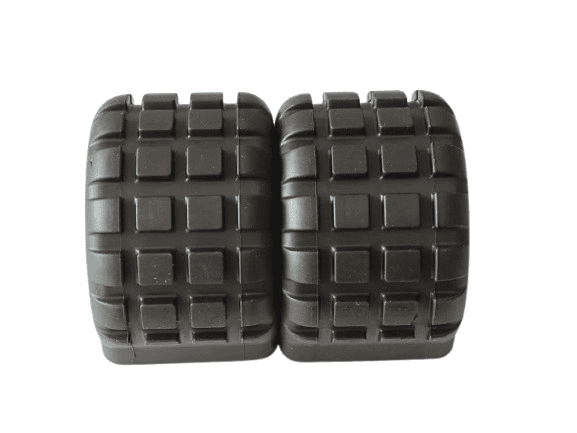Curious about what synthetic rubber is primarily made from? Understanding the main ingredients can clarify why synthetic rubber has become so versatile and widely used.
The main ingredient in synthetic rubber is petroleum-based monomers1, typically derived from crude oil or natural gas. The most common monomers used are butadiene, styrene, acrylonitrile, ethylene, and propylene, which are chemically combined (polymerized) to form various synthetic rubbers.

Let’s explore the key ingredients in synthetic rubber, why they're chosen, and their impact on the rubber's properties and performance.
What Is Synthetic Rubber?
Synthetic rubber is a man-made material that mimics the properties of natural rubber but is created through chemical processes rather than extracted from plants.
Synthetic rubber is made by polymerizing petroleum-based monomers, such as butadiene, styrene, and acrylonitrile. It can be tailored to achieve specific properties like flexibility, strength, chemical resistance, and heat tolerance, making it suitable for a wide variety of applications, including tires, seals, gaskets, and medical devices.
Types of Synthetic Rubber
| Synthetic Rubber Type | Main Ingredients | Key Properties | Applications |
|---|---|---|---|
| SBR (Styrene-Butadiene) | Styrene + Butadiene | Good abrasion resistance, low cost | Tires, automotive components |
| NBR (Nitrile) | Acrylonitrile2 + Butadiene | Oil resistance, good elasticity | Seals, gaskets, hoses |
| EPDM (Ethylene Propylene) | Ethylene + Propylene + Diene | Weather resistance, durability | Automotive seals, roofing |
Synthetic rubber’s ability to be customized for specific needs makes it widely used in various industries.
What Is the Most Common Synthetic Rubber?
The most commonly used synthetic rubber is Styrene-Butadiene Rubber (SBR)3, which is widely used in tire manufacturing and many other applications.
SBR is valued for its excellent wear resistance, good aging stability, and affordability. It is often used in the tread and sidewalls of tires, where durability and traction are most important.

Benefits of SBR in Tire Manufacturing
| Feature | Styrene-Butadiene Rubber (SBR) ✅ |
|---|---|
| Wear Resistance | Excellent |
| Cost | Low |
| Temperature Resistance | Good |
| Durability | High |
| Applications | Tread, sidewalls, general-purpose tires |
SBR is commonly used because it provides a good balance between cost and performance, making it ideal for many general-purpose applications, especially in the tire industry.
Why Are Petroleum-Based Monomers Used in Synthetic Rubber?
Wondering why petroleum-based ingredients dominate synthetic rubber production?
Petroleum-based monomers such as butadiene, styrene, and acrylonitrile are highly reactive, allowing manufacturers to engineer specific rubber properties. These monomers can easily polymerize to form durable, flexible materials tailored for precise applications in various industries, including automotive and industrial products.
Common Petroleum-Based Monomers
| Monomer | Properties Contributed | Used In |
|---|---|---|
| Butadiene | Elasticity, low-temperature flexibility | BR, SBR, NBR |
| Styrene | Strength, abrasion resistance | SBR |
| Acrylonitrile | Oil and chemical resistance | NBR (Nitrile Rubber) |
| Ethylene/Propylene | Weather resistance, flexibility | EPDM |
Petroleum-based monomers offer versatility in manufacturing rubber with customized performance characteristics.
What Are the Disadvantages of Synthetic Rubber?
While synthetic rubber offers many advantages, it also has certain disadvantages when compared to natural rubber.
One significant drawback of synthetic rubber is that it is not biodegradable, unlike natural rubber. Additionally, synthetic rubbers may not offer the same level of elasticity and resilience as natural rubber in some applications. Synthetic rubber is also derived from petroleum, which contributes to its environmental impact.
Disadvantages of Synthetic Rubber
| Disadvantage | Impact |
|---|---|
| Non-biodegradable | Environmental concerns |
| Lower Elasticity | Less flexibility in some applications |
| Environmental Impact | Petroleum-based source |
Synthetic rubber’s environmental impact and some performance limitations are important factors to consider, depending on the intended application.
How Does Acrylonitrile Influence Synthetic Rubber?
Acrylonitrile is essential for specialized synthetic rubbers, notably Nitrile Rubber (NBR).
Acrylonitrile imparts synthetic rubber with outstanding resistance to oils, fuels, and chemicals. The higher the acrylonitrile content, the better the oil resistance, making NBR ideal for automotive seals, fuel hoses, and industrial gaskets.
Acrylonitrile Content and Performance
| Acrylonitrile Content4 | Oil Resistance | Flexibility | Applications |
|---|---|---|---|
| Low (18-25%) | Moderate | High | Flexible seals, gaskets |
| Medium (30-35%) | High | Moderate | Automotive hoses, O-rings |
| High (40%+) | Excellent | Lower | Fuel lines, industrial seals |
The acrylonitrile content determines rubber's balance between oil resistance and flexibility, allowing tailored solutions for industrial applications.
How Are Ethylene and Propylene Used in Synthetic Rubber?
Ethylene and propylene monomers create EPDM5, a synthetic rubber known for superior outdoor durability.
Ethylene and propylene form Ethylene Propylene Diene Monomer (EPDM), offering excellent resistance to weathering, ozone, UV rays, and heat. EPDM rubber is commonly used in automotive weatherstripping, roofing materials, and outdoor seals due to its outstanding long-term performance in harsh environments.
Ethylene and Propylene in EPDM
| Property | EPDM Rubber Benefit |
|---|---|
| Weather Resistance | Highly resistant to ozone and UV |
| Temperature Stability | Excellent heat and cold resistance |
| Durability | Outstanding longevity outdoors |
| Applications | Automotive seals, roofing membranes |
Ethylene and propylene provide EPDM rubber exceptional environmental resistance, making it ideal for outdoor applications.
Conclusion
The main ingredients in synthetic rubber are petroleum-based monomers like butadiene, styrene, acrylonitrile, ethylene, and propylene. These monomers provide synthetic rubber with tailored properties like flexibility, chemical resistance, durability, and environmental resilience, making them essential materials across automotive, industrial, and consumer product industries.
🚀 Need Custom Synthetic Rubber Solutions?
Contact Julong Rubber today or Request a Custom Quote for tailored synthetic rubber products to meet your specific requirements!
Explore how petroleum-based monomers enhance the properties of synthetic rubber, making it versatile for various applications. ↩
Discover the role of acrylonitrile in enhancing oil resistance in synthetic rubber, vital for automotive and industrial uses. ↩
Learn about the advantages of SBR in tire production, including its durability and cost-effectiveness, crucial for automotive applications. ↩
Understanding Acrylonitrile Content is crucial for selecting the right rubber for specific applications, ensuring optimal performance and durability. ↩
EPDM rubber's unique properties make it ideal for outdoor use; exploring its benefits can help in choosing the right materials for your projects. ↩






